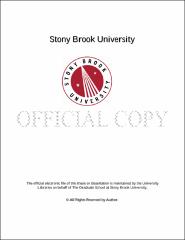| dc.identifier.uri | http://hdl.handle.net/11401/76188 | |
| dc.description.sponsorship | This work is sponsored by the Stony Brook University Graduate School in compliance with the requirements for completion of degree. | en_US |
| dc.format | Monograph | |
| dc.format.medium | Electronic Resource | en_US |
| dc.language.iso | en_US | |
| dc.publisher | The Graduate School, Stony Brook University: Stony Brook, NY. | |
| dc.type | Dissertation | |
| dcterms.abstract | Dinoflagellates can cause harmful algal blooms (HABs) associated with human health syndromes such as paralytic shellfish poisoning (PSP) and diarrhetic shellfish poisoning (DSP) and these HABs are a growing concern in many coastal regions. My dissertation explored the factors promoting toxic dinoflagellate blooms in estuarine ecosystems. Northport Bay, NY, which has experienced chronic PSP-induced shellfish closures due to the toxic dinoflagellate <italic>Alexandrium fundyense</italic> and blooms of the DSP-producer, <italic>Dinophysis acuminata</italic>, was used as a natural system to explore these factors while multiple strains of <italic>A. fundyense</italic> and a newly established <italic>D. acuminata</italic> culture isolated from North America were investigated in controlled, laboratory experiments. Culture experiments, field experiments, and field observations demonstrated that North American strains of Alexandrium were capable of allelopathically inhibiting competing autotrophic nanoflagellates and diatoms. This inhibition contributed to elevated organic matter production, bacterial respiration, and pCO2 levels during Alexandrium blooms. Levels of pCO2 recorded in Northport Bay (~1700&muatm) were highest in regions with the greatest Alexandrium abundances. Culture and field experiments demonstrated that elevated pCO2 (~1700&muatm) enhanced Alexandrium growth rates and, on occasion, toxicity, suggesting that blooms may be promoted by coastal ocean acidification. Dinophysis acuminata blooms exceeding one million cells L-1 were documented for the first time anywhere during my dissertation, and in several cases DSP toxins in shellfish exceeded the USFDA action level (160 ng g-1 of shellfish tissue). A four year field investigation of D. acuminata blooms revealed that abundances were significantly correlated with multiple nutrients. Field and culture experiments demonstrated that both inorganic and organic nutrients were capable of significantly enhancing Dinophysis growth and toxicity. Hence, this dissertation provides the first evidence that blooms of this ubiquitous, toxic dinoflagellate can be directly promoted by nutrient loading. This dissertation demonstrated that multiple, biological and chemical factors can act in combination to promote dinoflagellate growth and toxicity which, in turn, can affect human health and local economies. Hence, these findings contribute toward the information needed to develop management practices that mitigate blooms and protect human health. While factors such as competition, nutrients, and acidification were investigated here, additional factors that affect dinoflagellate blooms warrant future exploration. | |
| dcterms.available | 2017-09-20T16:49:36Z | |
| dcterms.contributor | Gobler, Christopher J | en_US |
| dcterms.contributor | Lonsdale, Darcy | en_US |
| dcterms.contributor | Collier, Jackie | en_US |
| dcterms.contributor | Ammerman, James | en_US |
| dcterms.contributor | Morton, Steven. | en_US |
| dcterms.creator | Hattenrath, Theresa K. | |
| dcterms.dateAccepted | 2017-09-20T16:49:36Z | |
| dcterms.dateSubmitted | 2017-09-20T16:49:36Z | |
| dcterms.description | Department of Marine and Atmospheric Science. | en_US |
| dcterms.extent | 297 pg. | en_US |
| dcterms.format | Application/PDF | en_US |
| dcterms.format | Monograph | |
| dcterms.identifier | http://hdl.handle.net/11401/76188 | |
| dcterms.issued | 2015-08-01 | |
| dcterms.language | en_US | |
| dcterms.provenance | Made available in DSpace on 2017-09-20T16:49:36Z (GMT). No. of bitstreams: 1
Hattenrath_grad.sunysb_0771E_11778.pdf: 2784543 bytes, checksum: e2de3fa70e478692bf1e9a1b888e529a (MD5)
Previous issue date: 2014 | en |
| dcterms.publisher | The Graduate School, Stony Brook University: Stony Brook, NY. | |
| dcterms.subject | Alexandrium, dinoflagellates, Dinophysis, harmful algae, toxins | |
| dcterms.subject | Biology | |
| dcterms.title | An investigation of the mechanisms promoting toxic dinoflagellate blooms in estuarine ecosystems | |
| dcterms.type | Dissertation | |

